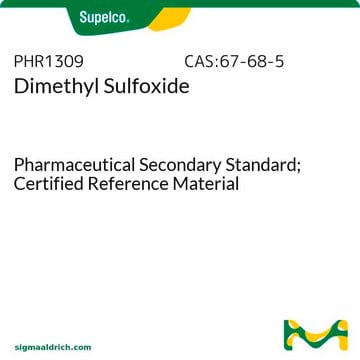1211006
USP
Dimethyl sulfoxide
United States Pharmacopeia (USP) Reference Standard
Synonym(s):
DMSO
About This Item
Recommended Products
grade
pharmaceutical primary standard
vapor density
2.7 (vs air)
vapor pressure
0.42 mmHg ( 20 °C)
autoignition temp.
573 °F
expl. lim.
42 %, 63 °F
manufacturer/tradename
USP
availability
not available in (Sales restrictions may apply)
refractive index
n20/D 1.479 (lit.)
bp
189 °C (lit.)
mp
16-19 °C (lit.)
density
1.10 g/mL (lit.)
application(s)
pharmaceutical (small molecule)
format
neat
SMILES string
CS(C)=O
InChI
1S/C2H6OS/c1-4(2)3/h1-2H3
InChI key
IAZDPXIOMUYVGZ-UHFFFAOYSA-N
Looking for similar products? Visit Product Comparison Guide
General description
Application
- Dimethyl Sulfoxide Irrigation
- Dimethyl Sulfoxide Gel
- Dimethyl Sulfoxide Topical Solution
- Methylsulfonylmethane
Caution
Analysis Note
Other Notes
related product
Storage Class Code
11 - Combustible Solids
WGK
WGK 1
Flash Point(F)
Not applicable
Flash Point(C)
Not applicable
Regulatory Listings
Regulatory Listings are mainly provided for chemical products. Only limited information can be provided here for non-chemical products. No entry means none of the components are listed. It is the user’s obligation to ensure the safe and legal use of the product.
FSL
Group 4: Flammable liquids
Type 3 petroleums
Hazardous rank III
Water soluble liquid
JAN Code
1211006-3G:
Certificates of Analysis (COA)
Search for Certificates of Analysis (COA) by entering the products Lot/Batch Number. Lot and Batch Numbers can be found on a product’s label following the words ‘Lot’ or ‘Batch’.
Already Own This Product?
Find documentation for the products that you have recently purchased in the Document Library.
Customers Also Viewed
Our team of scientists has experience in all areas of research including Life Science, Material Science, Chemical Synthesis, Chromatography, Analytical and many others.
Contact Technical Service


